How Do You Craft the PERFECT Dynamic Between Protagonist and Antagonist?
The conflict between the protagonist and antagonist is an essential part of screenwriting.
However, this crucial conflict can often be a conflict between three characters rather than just two.
We’re going to take a look at what defines a great dynamic between a protagonist and antagonist.
First of all, let’s define protagonist, antagonist and the secret third ingredient – “The Stakes Character”.
Defining ‘Protagonist’
A protagonist is the main character in the TV show or film.
- They are seen by the audience as the hero and learn a lesson throughout the film.
- The protagonist often works for the greater good.
- Though occasionally protagonists can be seen to break rules, ultimately, their intentions are for good.
- Good intentions might be hard to find with certain protagonists.
- But a great protagonist will always make us see their side no matter the character of their actions.
Here are some examples of protagonists that fit that bill:
Katniss Everdeen

The protagonist of The Hunger Games must enter the Hunger Games competition to save her District.
- Her District is the poorest and least populated within this fictional world.
- We therefore are instantly on her side as the underdog.
Katniss’s strength of character in her rebellious and morally centred heart makes her a compelling protagonist. She’s also talented, intelligent and savvy, as she demonstrates within the competition.
Harry Potter
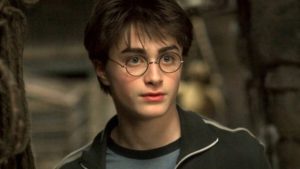
The fate of the wizard world ultimately rests on Harry’s shoulders. The inadvertent bond created between him and Voldermort when he was a baby, make this the case.
- Harry is an orphan, badly treated by his adoptive family.
- He is ostracised by both the muggle and wizard world.
These characteristics put the audience on his side. Sometimes Harry’s behaviour represents a journey to being morally good rather than being inherent. Harry’s journey throughout the series means that he is constantly learning.
Mildred Hayes
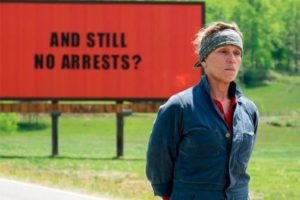
The protagonist of Three Billboards Outside Ebbing, Missouri. She works to find her daughter’s killer in the face of a disinterested police force.
She’s plucky, funny and stubborn in the face of dangerous complacency – all characteristics that make her a beguiling protagonist.
Bruce Wayne
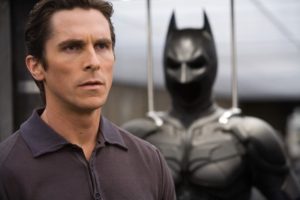
In fighting to protect a degraded society from predators, Bruce Wayne proves himself a hero.
He uses his wealth to fight for good where the state of gotham has failed. In doing so undercover, he proves the selflessness of his actions.
Furthermore, Bruce’s many antagonists always make him learn different things about the way in which villains seek to take advantage of a vulnerable society.
Walter White

An unconventional and difficult protagonist to like due to the increasing moral bankruptcy of his actions. However, his ultimate intentions, to protect and care for his family in the face of his terminal cancer, are what counts as his greater good.
Throughout Breaking Bad, the degraded ways Walter tries to achieve his goals continually challenge the audience to not be on his side. This leads to a larger debate about what the ‘greater good’ really means.
Is looking after his family worth the larger harm that Walter causes in order to achieve this? This is one of the main take away questions from the series overall.
Defining ‘Antagonist’
The antagonist is typically seen as the ‘baddy’ in a TV show or film. They work against the protagonist.
- Often their intentions are to take something away from or cause pain to the protagonist.
- A group of characters, an organisation or something altogether more conceptual, can also serve as the antagonist.
Obstacles aren’t always antagonists. They can sometimes just serve the function of creating obstacles for the protagonist to tackle throughout the TV show or film. Often the line is blurred.
- The key distinction is that an antagonist will be there for the protagonist to overcome throughout the series or film.
- Furthermore, their defeat will signal the end of the story.
- Think of an obstacle as your level boss, whilst your antagonist is your final boss.
Here are some examples of antagonists that fit that bill:
Erik Killmonger

In Black Panther, Erik Killmonger seeks to undermine T’Challa’s claim to throne of Wakanda.
- In the end, he can only be defeated by the very character that he works in opposition to.
- He also has a past, familial connection to the protagonist – another classic antagonist trope.
Erik’s anger with Wakanda stems from the way in which they have protected themselves throughout history and not helped those of African descent struggling in the outside world.
Ultimately, T’Challa learns from Killmonger. After necessarily defeating him T’Challa imparts what Killmonger has taught him.
Tracy Flick
In Election, Tracy Flick is the precocious high school student who frustrates high school teacher, Jim McAllister.
She starts out as a student that Jim McAllister finds mildly annoying. But she ends up the cause of the down-spiralling of his life.
Jim goes from being one of the most beloved teachers in the school to a social outcast, losing his job, marriage and friends.
- Jim starts out as a character that seems pretty contented.
- Tracy serves the purpose of unravelling his insecurities.
- These are insecurities which end up defining and destroying him.
- Tracy comes to represent everything that Jim feels he is not.
It’s in the way Tracy acts as a mirror for Jim’s deep underlying issues that she serves as a brilliant antagonist.
Terence Fletcher

In Whiplash, the protagonist is talented first-year jazz drummer Andrew Neiman (played by Miles Teller). The antagonist – the terrifying conductor and teacher Terence Fletcher (played by JK Simmons).
Andrew’s world so far has been one of positive reinforcement. He excels at playing the drums and has just gotten into a prestigious music school.
Terence Fletcher destroys all that. He invites Andrew into his Studio Band and catapults him into a world in which nothing is ever good enough.
Andrew goes from being ambitious and excited about his future to that ambition defining every element of his life. It eats up all of his personal life and takes him to the brink of a breakdown.
Thanos
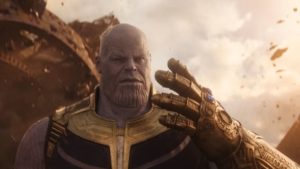
Thanos is the ultimate antagonist for The Avengers to defeat.
- The Avengers must unite to save the universe from Thanos.
- Thanos seeks to solve universal overpopulation by genocidally wiping out large populations.
Thanos is a thrilling antagonist as his goal remains unclear for a large part of the series. Furthermore, he is so powerful it takes a whole supergroup of superheroes to defeat him. This proves how much the odds are stacked in his favour initially.
King George VI’s Stammer
In The King’s Speech, the speech stammer that King George VI seeks to overcome serves both as an unconventional and traditional antagonist.
- It’s unconventional in the sense that it is not a person.
- Whilst, it’s traditional in the sense that it provides a very clear obstacle for the protagonist to overcome throughout.
A speech therapist, Lionel Logue (played by Geoffrey Rush) helps The King (played by Colin Firth) to try and overcome his stammer.
The antagonist is simple as it is clearly identifiable. However, it’s complex as it takes significant probing into George’s character and backstory to find out why the stammer exists in the first place.
It may not to be personified but the stammer proves to be an elusive and effective antagonist to overcome.
Defining ‘Stakes Character’
A stakes character is defined as
the personified character that represents all of the people the antagonist is victimizing.
Often overlooked, this character is someone or something personal to the protagonist that they feel deeply about.
Therefore the stakes of losing this personified character are motivation enough to fight the antagonist in a bid to save them.
Here are some examples of stakes characters that fit that bill:
Mary-Jane Watson

Mary-Jane is Peter Parker‘s way of relating to the world he is constantly trying to save.
Whilst he is often characterised as an outsider, ostracised from school and from society, MJ is his beacon of hope.
She’s the one who he feels is worth saving. Consequently, she represents the society at large that has to be saved by the villains that threaten it.
Andy (Toy Story)
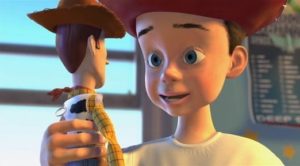
In the first Toy Story, Woody is the protagonist whilst Sid (the sadistic boy who tortures his toys) is the antagonist.
For Woody, the character at stake is Andy. Whilst Andy doesn’t need saving explicitly, Woody’s relationship with Andy is what is at stake.
Woody will do anything to keep the relationship the way it is. Meanwhile, Sid represents the exact opposite of the ideal relationship between Toy and owner.
Liz (Shaun of the Dead)
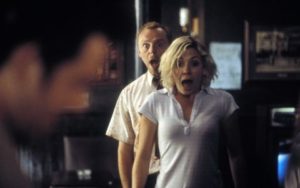
Under the threat of imminent Zombie apocalypse, the world is at stake for Shaun. However, as soon as the world is under threat his first thoughts turn to Liz, the girlfriend he has just broken up with.
- Shaun rushes to save his mum too. However, it’s clear that his relationship with Liz is what changes in the face of the Zombie threat.
- Whereas in normal life they had just broken up, the threat of extinction puts things into perspective.
Shaun is forced to change the ways he was stuck in. He becomes the pro-active and intelligent thinker Liz knew him to be but was frustrated he let slip in their relationship together.
Kevin (Moonlight)

Chiron is the protagonist of Moonlight. There are a number of different antagonists – from class bullies to more conceptual notions of societal barriers.
The character that remains in Chiron’s mind and ultimately forces him to confront his sexuality, is Kevin.
- Chiron and Kevin are always close and have a sexual encounter as teenagers (in the second of the film’s three acts).
- As an adult, Chiron still thinks about Kevin but doesn’t seek him out. Eventually, it’s Kevin who seeks Chiron out but who means enough to Chiron to change the way he is.
- Chiron is open and honest about his sexuality, admitting to Kevin that he’s the only man he’s ever been with.
Throughout the movie, Kevin is the force of change in Chiron’s life. He’s the character that in the face of opposing forces, he can be his true self with.
Captain Steve Trevor (Wonder Woman)
For Diana, the titular Wonder Woman, Captain Steve Trevor is the representation that humans are worth saving.
- Safe from the world’s troubles in their own secret island, the women of Themyscira don’t want to help out humanity in World War I.
- However, Diana gets to know Steve when he ends up crashing on Themysicra.
- In getting to know him, she realises what is at stakes by humanity being under threat.
- She can no longer, like her fellow islanders, ignore the plight of man and the imminent threat they are under.
High Stakes
Every protagonist and antagonist will have something at stake which motivates them throughout the TV show or film.
High stakes, ultimately, are used to show something is at risk for the protagonist if they are unsuccessful in their goal.
- The stakes should be apparent throughout the screenplay.
- The focus should be drawn to it during the logline, every act, sequence and scene.
The ultimate stake that could be seen in a TV show or film would be death. These Death stakes could be literal or figurative. Examples of this vary dependant of the genre.
- For example, in horror or action, death stakes are often used in the literal sense.
- However, in comedy this could be seen more figuratively. Death in this case might be severe embarrassment, humiliation or unrequited love, for example.
Even minor characters in a screenplay should also have a goal or something at stake. Stakes are what motivate characters into action. And action and conflict is what makes for good drama and impactful storytelling.
Stakes Character, Protagonist and Antagonist
In order to create this triangle between the stakes character, protagonist and antagonist, there must be a power struggle.
- This three way power struggle between the stakes character, the protagonist and antagonist is what increases the worth of these already high stakes.
This third character, in addition to the protagonist and antagonist, creates a third dimension which helps to solidify the conflict seen throughout the TV show or film.
Let’s look at some examples of the Stakes Character, Protagonist and Antagonist Triangle of Conflict…
Se7en

Protagonist – William Somerset.
Antagonist – John Doe.
Stakes Character – David Mills/Tracy Mills.
In Se7en, Detective William Somerset (Morgan Freeman) seeks to solve the serial killings carried out by John Doe (Kevin Spacey).
William forms a close relationship with his partner, David Mills (Brad Pitt) and his wife, Tracy Mills (Gwyneth Paltrow).
- John Doe represents a sick society, to William.
- David and Tracy (as well as their unborn child) represent youth, hope and the future worth saving from evil cynicism like John Doe’s.
Bridesmaids

Protagonist – Annie.
Antagonist – Helen.
Stakes Character – Lillian.
In Bridesmaids, Annie’s (Kristen Wiig) best friend relationship with Lillian (Maya Rudolph) is at stake.
Lillian prepares for her wedding. The seemingly perfect Helen (Rose Byrne) is the new friend and bridesmaid who seems to be taking Lillian away from Annie.
The Dark Knight
Protagonist – Bruce Wayne.
Antagonist – The Joker.
Stakes Character – Harvey Dent.
In The Dark Knight, the Joker is Batman’s villain to defeat.
- It might seem that Rachel Dawes (Maggie Gyllenhaal) is the obvious stakes character, being Bruce’s love interest.
- However, the stakes character is actually Harvey Dent (Aaron Eckhart).
Harvey’s plan to disrupt organized crime in the city represents hope for the city of Gotham. The Joker seeks to undermine that and eventually Bruce can’t save Harvey. Harvey is poisoned by the Joker’s message and becomes Two-Face.
The Shape of Water
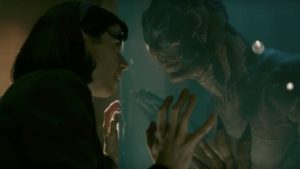
Protagonist – Elisa Esposito.
Antagonist – Richard Strickland.
Stakes Character – Amphibian Man.
In The Shape of Water, when a mysterious Amphibian creature is captured by the government, Elisa (Sally Hawkins) forms a relationship with him.
Richard Strickland (Michael Shannon) threatens Elisa’s relationship with this tender creature. Richard is in charge of the operation to study the Amphibian Man, subjecting him to tortuous methods.
Finding communication limited and difficult (she is mute), Elisa’s instinctive bond with the Amphibian Man is what is at stake.
Star Wars
Protagonist – Luke Skywalker.
Antagonist – Darth Vader.
Stakes Character – Princess Leia.
A very traditional but efficient example is present in Star Wars: A New Hope.
- Luke is the protagonist, whilst Darth Vader is the antagonist.
- Leia needs saving and therefore is the stakes character.
- However, as Luke’s sister she also represents the family that Luke never had and seeks to get back.
How to Construct Conflict Between Stakes Character, Protagonist and Antagonist
So, the stakes character is what brings the protagonist and antagonist together in a head to head ‘battle’.
Usually it is the final battle which decides whether the protagonist was successful or unsuccessful in their mission.
- This ‘battle’ doesn’t have to be literal. A battle simply represents the different conflicting forces coming together all at once.
In general, the stakes character is often the protagonists ‘love interest’. However, the above examples show that there are ways of subverting this.
- Either the ‘love interest’ can serve as a cipher for the real stakes character (as in The Dark Knight).
- Or the love interest could be a platonic love (as in Bridesmaids or Se7en).
When constructing three-way conflict between the stakes character, protagonist and antagonist, it is important to make sure they are all equally matched.
It needs to be convincing that the protagonist can defeat the antagonist. Similarly, it needs to be convincing that the stakes character is worth caring about.
The Protagonist’s conflict
- A flaw in many screenplays is that there is nothing for the protagonist to struggle for or learn from. The protagonist’s goal feels too easy to achieve.
- Or often there isn’t a character who represents what the protagonists’ life would be like if they were not to achieve their goal.
- Providing an image of what the characters life would be if they were to not achieve their goal instantly heightens the stakes.
The Antagonist’s goal
For an antagonist, their goal also needs to be clearly, convincingly defined. Is their characterisation deep enough for us to understand their actions?
- For example, this not being the case would be a villain who just wants to destroy the world for the sake of it.
- Classic villains like the Joker or Thanos have an ideology that underpins why they are the way they are. Consequently, the need to defeat them feels palpable.
The relationship between the Protagonist and Stakes Character
In terms of the stakes character, it needs to be realistic that the protagonist would struggle so much for them. Is it convincing that the protagonist cares this much about the stakes character?
- For example, a weak stakes character would be a character who feels like a two-dimensional love interest. This might be a damsel in distress type, for example.
Always think not just about what the stakes character means to the protagonist but what they represent.
- Do they represent love, or family, or humanity, or society, or the past, or the future?
- What could the stakes character be a metaphor for?
These are key questions to ask of your stakes character.
Do the Protagonist and Antagonist Have The Perfect Dynamic? Checklist:
Think you have a great protagonist an antagonist dynamic? Here are some final key things to remember and check off.
- Stakes which are apparent in the logline, every act, sequence and scene.
- Stakes character is present throughout the screenplay.
- Every character in the screenplay has their own stakes.
- There is a power struggle between the protagonist, antagonist and stakes character.
- The character struggles to achieve something within the screenplay.
- There is a character or circumstance that stands in the way of the protagonist achieving their goal.
- There is a visual and personified idea of the stakes if the protagonist were to be unsuccessful.
- The stakes are what bring your protagonist and antagonist together in a head to head battle. Rather than some other external event or incident.
Overall, remember that the key to a great protagonist and antagonist dynamic is not just about conflict with one and other.
It’s about having something worth fighting over.
- What did you think of this article? Share it, Like it, give it a rating, and let us know your thoughts in the comments box further down…
- Struggling with a script? Story analysis is what we do, all day, every day…check out our script coverage services for writers & filmmakers.
Get *ALL* our FREE Resources
Tackle the trickiest areas of screenwriting with our exclusive eBooks. Get all our FREE resources when you join 60,000 filmmakers on our mailing list!

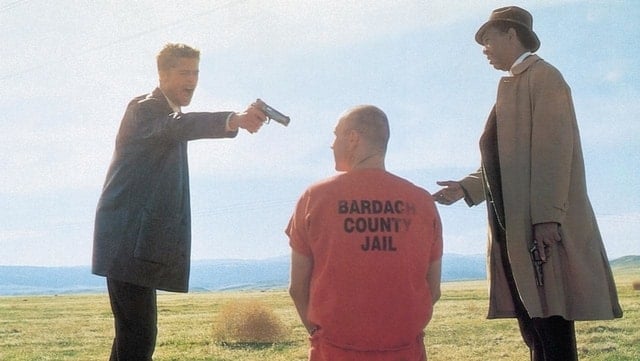
Whether you have the traditional hero-villain character dynamic, or a non-traditional character rivalry, remember to make full use of the conflict their interactions generate in order to move your story along. By creating complex characters, you will find it much easier to develop an interesting plot and bring your story to life.
kewl